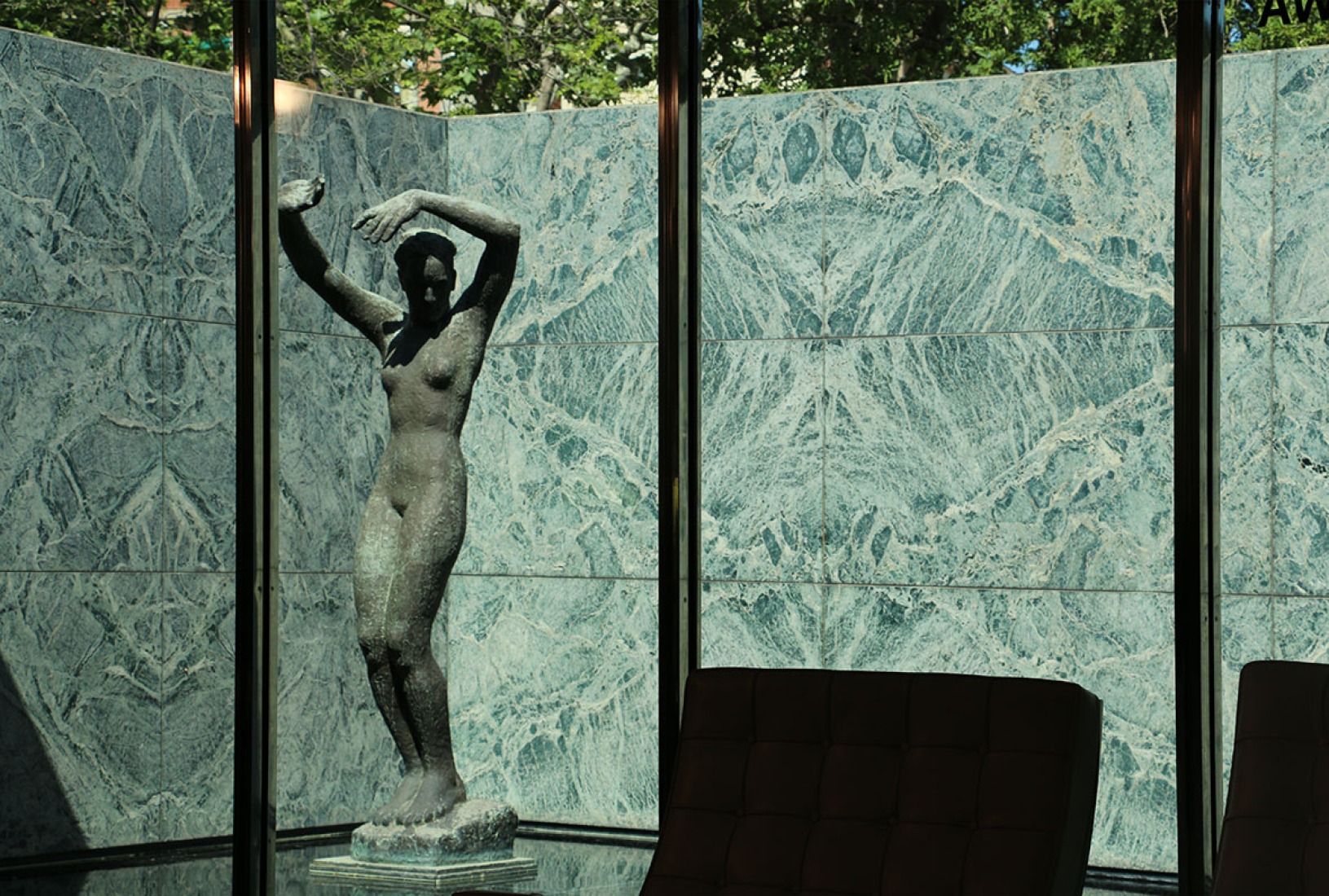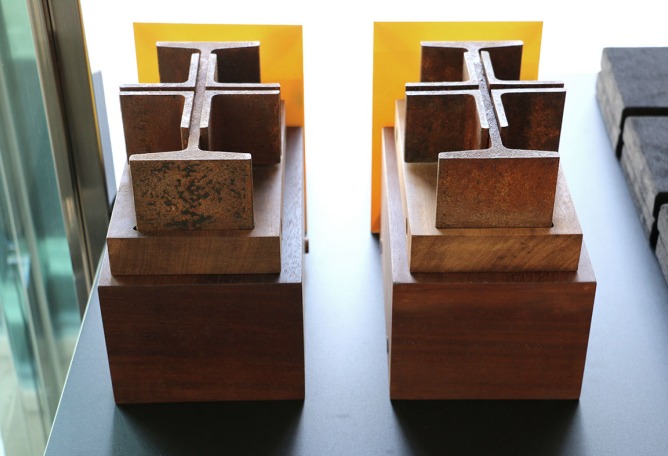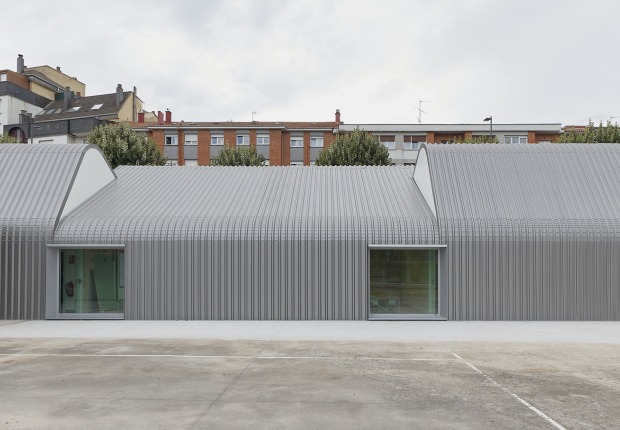On a day completely clear, the pavilion wore its best clothes, the scenery was worthy of the "Architecture´s Oscars". The guests began to arrive, entering the pavilion through a black carpet, including the five finalists. After a first meeting around the Pavilion´s pond, some of the guests arrived just in time, BIG ran down the hall in his suit and scrupulously white sneakers.
Quickly all the seats were occupied inside the pavilion. With the Kobe sculpture's expectant eyes observing the room and the hostess protecting the two awards in two yellow envelopes containing the names of the winners, the finalists took their seats, from the friendly Tomey couple, some of the authorities who promoted the work, to the awards´ jury.
Those responsible for the Foundation, Giovanna Carnevali, introduced the ceremony and quickly gave way to the Jury's President, Zino Zucci, who once was an emerging young Italian architect. The first announcement was to introduce the Emerging Architect Award, the winners: Architecture G. A, a group of four very young architects.
After the surprise of the first announcement, and the award to Jonathan Arnabat (1977 Spain), Aitor Fuentes (1981 Spain), Igor Urdampilleta (1981 Spain), Jordi Ayala (1975 Spain) for the renovatiom of a small house in Extremadura, the president continued to conduct a preliminary description of the virtues of each of the five finalists along with images displayed on a screen. In a scenographical and calculated process Zino Zucci received the second yellow envelope with the name of the winners.
As he opened it, the faces of the architects were a reflection of their personalities: O’Donnell + Tuomey apparently quiet, the two authors of Art Museum in Ravenbsurg Arno Lederer, JórunnRagnarsdóttir y Marc Oei, serious, accordingly to two German architects, Bjarke Ingels with undisguised tension (hands folded, his body leaning slightly forward in his chair and his legs crossed tightly under the seat), the Italians with a different, more relaxed nerves, and finally also serious Fabrizio Barozzi (1976 Italy) y Alberto Veiga (1973 Spain).
Zucci opened the envelope and handed it to the President of the Foundation for announcing the name written in the envelope. He came to the podium, remained silent for a few seconds and finally pronounced the name of the winners: The Philharmonic by Varozi and Veiga.
Few times the expectation breaks into cheers and applauses as the ones expressed yesterday by friends, relatives and political leaders of the project. The acclaim was especially warm when they raised from their seats.
In parallel.-
Minutes before the beginning of the ceremony I spoke with some of the attendees, including one of the members of the jury, who asked me what my pool was in a smart attempt to avoid the question before the ceremony. Describing who the winner could be, who had options and who did not, the typical situation occurred, that in which you don't remember the names of the possible rejections and you need to ask their name. If the members of the jury can't remember them, it means that your pool is pretty close. By the way, we got it right.
Yesterday's result is the ending of a process in which Europe still reflects its own situation as a complex group of tribes with their own differentiated identities, from the rigid positions that seek to bring the truth of the German area, through the Anglo-Saxon pontificators, to the rest of the world, expectant and hungry for recognition.
Many commented that being the prize awarded to an outstanding work, it pushes into the background excellent and consolidated careers. In this first group were leading the Irish O'Donnell + Tuomey, with a brilliant project, but overly complex and whose versatility in trying to cover all the program with specific responses is an indication of its own rigidity, despite its excellent urban integration and the brilliant use of brick as outer skin. Facing this complexity, the German group, with a project that pretends to recover a Nordic classicism, with perfect execution of the envelope, but with an empty, simple and cold inside, a container where even the light treatment is distant and the stairs just a group of steps.
In parallel, Archea Associati project, well resolved, with well-executed formal gestures, integrated in the territory, but too bombastic in the reception areas and the scenery of the winery. The silence of the creation of wine, broken by the views of the meeting room. In this second group of well-executed projects is Bjarke Ingels's, also with well-learned languages and gestures as shown in the auditorium, a faithful replica of the Kunsthal's auditorium by Rem Koolhaas, with a good project idea, simple but effective and this time yes, simple and intelligent, although their contribution to architecture is rather limited.
Finally, the winners, Barozzi and Veiga. On one side the big surprise, many of the attendants commented that it could have perfectly been an emerging architecture award, given their youth for these kinds of awards, on the other side, its iconic condition, which the architects sought in all the interviews to put some distance and let it fade before their interviewers.
The reality is that the project won. The best project of those who had reached the final. On the way were left projects that one considers as proposals with even more interest than some of those that reached this point, with a higher risk, with a proactive capacity, and in that sense the compilation of the 420 selected is a clear reflection of the European architecture's reality.
The winner was obvious in any pool: iconic, striking photographically speaking, formally clear and well solved. The winners, deserved to win and in this sense the jury was right. Inside the bedroom, as already said, is this the end of a time for an architecture that speaks of formalities and icons? or is it the beginning of a time for other ways and proposals to come, suggested in the group of the 420?
The last 5 winners.-
2013 Harpa-Reykjavík Concert Hall & Conference Centre, Reykjavik. Henning Larsen Architects / Peer Teglgaard Jeppesen, Osbjørn Jacobsen Studio Olafur Eliasson / Olafur Eliasson Batteríid architects / Sigurður Einarsson.
2011 Neues Museum, Berlín, David Chipperfield Architects / David Chipperfield, in collaboration with Julian Harrap.
2009 Norwegian National Opera & Ballet, Oslo, SNØHETTA / Kjetil Trædal Thorsen, Tarald Lundevall, Craig Dykers.
2007 MUSAC Contemporary Art Museum of Castilla y León, León Mansilla + Tuñón Arquitectos / Luis M. Mansilla, Emilio Tuñón.
2005 Netherlands Embassy, Berlín, OMA / Rem Koolhaas , Ellen van Loon.




























